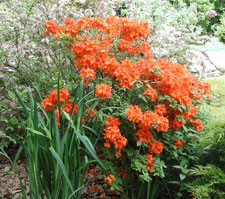Resource Library
Plant of the Week: Hybrid Azalea
The University of Arkansas System Division of Agriculture does not promote, support or recommend plants featured in "Plant of the Week." Please consult your local Extension office for plants suitable for your region.
Plant of the Week
Hybrid Azalea
Latin: Rhododendron Deciduous

Azaleas come in two basic flavors: the ever popular evergreen kinds and the not-so-common deciduous hybrids. The deciduous hybrids were first to be grown in gardens and didn’t yield to the evergreen types until the end of the Victorian era.
Native deciduous azaleas are seldom grown in gardens. The deciduous hybrids are favored by nurserymen because they have more vigor than the wildlings, and their wild cousins are notoriously difficult to propagate.
Besides the obvious absence of leaves during the wintertime, the deciduous azaleas have one other major difference. Their flower colors are hot. Really hot. Bloom trusses often are arranged like round balls at the end of bare stems with colors ranging from deep orange to bright yellow.
These visually jarring colors are often shunned by color sensitive garden designers, but those of us with little taste or restraint when gaudy colors are involved love them.
Most deciduous azaleas have a slow to moderate growth rate with an erect to upright-oval form. While seldom seen in gardens at more than 5-6 feet tall, they have the potential to reach twice that given enough time. However, as with all azaleas, height is easily controlled by pruning.
Deciduous azaleas made their way to European gardeners during the late 18th and early 19th centuries. The eastern United States is home to about 15 species, while the Orient has a similar number of species, but in both cases, only two or three were used as parents in the first hybrids.
The Ghent (Belgium) hybrids were the first to be developed with the earliest appearing during the 1830s.
These early hybrids involved species then growing in European gardens and included R. calendulaceum (the flame azalea from the southern Appalachians), R. periclymenoides (the sweetly fragrant pinxterbloom azalea found in the Appalachian lowlands to the gulf coastal plains of the eastern states), R. molle (from China) and R. luteum (from southern Europe and Asia Minor).
Anthony Waterer, an English nurseryman especially remembered for the spirea he developed, began serious breeding efforts in the 1860s. He combined the Ghent hybrids with the Chinese species and others as they became available. The azaleas he and his son developed became the Knap Hill hybrids.
In the 1920s Lionel de Rothchild of Exbury, England, used the Knap Hill hybrids as the basis for the Exbury azaleas he developed.
About the same time Waterer was making azaleas crosses, Louis Van Houtte of Belgum began developing the Mollis hybrids.
Van Houtte used R. molle from China and R. japonicum from Japan as the basis of his hybrids but occasionally added North American species such as R. viscosum (the swamp azalea). The “Northern Lights” deciduous azaleas developed at the University of Minnesota Arboretum in the 1970s combine the Mollis bloodline with that of R. prinophyllum, the most cold hardy of our native azaleas.
The Exbury and Knap Hill hybrids tend to have poor heat tolerance and don’t bloom as well in southern climates. The Aromi hybrids combine the best Exbury hybrids with the Florida azalea (R. austrinum) to create more heat-tolerant deciduous azaleas.
Deciduous azaleas are not as foolproof as their evergreen cousins. While they require the same acidic soils and excellent drainage as their evergreen cousins, they also have need for brighter locations. If given too much shade or if plants are allowed to get too dry in midsummer, blooming will be reduced the following year. They will grow in full sun.
Because deciduous azaleas tend to be a bit leggy during the winter, they’re often planted behind modest-sized evergreen shrubs. Powdery mildew has been a significant problem with many deciduous azalea selections, but nurserymen and breeders are working to rid the ranks of those afflicted by the disease. Deciduous azalea availability from local nurseries tends to be spotty, so finding a specific cultivar or even hybrid group can be hit or miss.
By: Gerald Klingaman, retired
Extension Horticulturist - Ornamentals
Extension News - April 25, 2008
The University of Arkansas System Division of Agriculture does not maintain lists of retail outlets where these plants can be purchased. Please check your local nursery or other retail outlets to ask about the availability of these plants for your growing area.